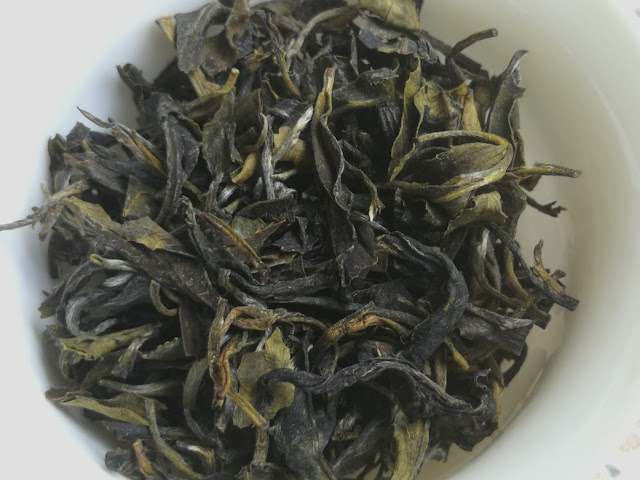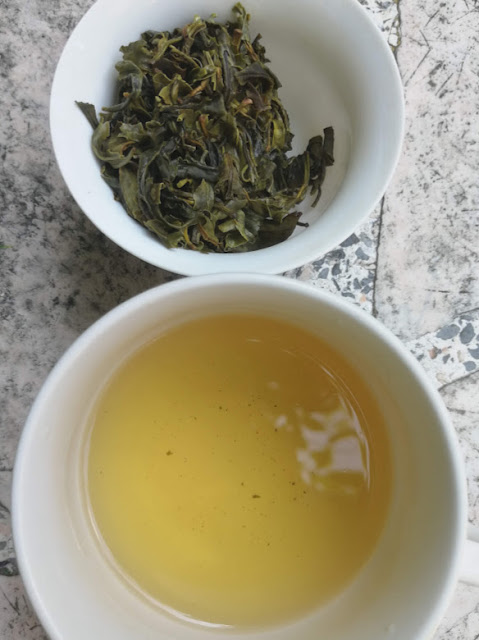I'm reviewing the last of a set of tea samples from that tea contact in Georgia (the country), Nika Sioridze. There was no particular reason for waiting months to get to it, I just tapered off reviewing in the last couple of months of last year and have a few more varied teas around to try as a result. Most are really interesting too, including Wuyi Yancha from Cindy (of Wuyi Origin), another US tea from Jason of the Mississippi farm, and a bit of Gopaldhara Darjeeling.
I didn't know what the tea was prior to trying it but the color is a clue; it was probably green tea or light oolong, resembling a baozhong style in appearance.
It makes sense to include a little more about Nika and Greengold; I think this tea might be one that goes by the name Greengold (the company name). That description doesn't mention oxidation level so I'm guessing by dry leaf appearance, which changes a lot just in relation to lighting and camera settings.
We talked to Nika in an online meetup summarized here. That included a comparison tea review of two of their black teas, not normally how I do that. This post reviews what I interpreted to be two of their oolongs, but one thing confusing this (beyond the samples not being labeled) is that they use local branding names for the teas, not tea type names. So there are some descriptions for them online, and a presentation through the site with more details, but the mapping is to a separate name type (eg. Fire of Dragon oolong goes by Daisi on their site, I think).
As with any other person or vendor you could reach out with questions about types through their Facebook page, and I did talk to Nika about what this probably is, probably a light oolong. Or maybe it's that they aren't even trying to replicate a particular Chinese or Taiwanese style, so a partially oxidized but quite green tea is essentially an oolong, but not necessarily a copy of baozhong style.
 |
a more spread out arrangement shows off the leaf color variation better |
Review:
first infusion: really light; brewed fast. Results are promising but this will need a longer infusion time to tell more of a story, and often the first infusion is more about wetting the leaves, since I wouldn't use a rinse with a tea like this. Flavors are bright, floral and creamy, with a touch of vegetal edge. This seems closest to very lightly oxidized oolong range, baozhong / pouchong, but it really could be a green tea for all the more I'm picking up so far. If it is a green tea that ended up oxidizing a little along the way it might not be far off really light oolong range anyway. A citrus like edge in this is especially interesting, bright and intense, out towards lemon. Great sweetness helps it all really pop.
second infusion: vegetal range is stronger than I'm accustomed to, for being off green teas for so long. I may never conclude if this is a green tea that oxidized a little or if they intentionally oxidized it, since it seemed like a light oolong last round and further towards green tea this one, but still like a light oolong. There's a really catchy aspect in this that makes it work well. It's probably a set of flavors, that towards-lemon citrus, combining with a bright and light underlying warmer range, like some kind of grain, and also complex floral tones. The vegetal part isn't like bell pepper or bean or anything like that, closer to the sweetness of a sugar snap pea.
Then there's also a touch of astringency edge that compliments the rest well enough, that is hard to tie to making the most sense with a certain flavor, that seems to link to it. For example floral range often seems to tie to something like plant stem. This isn't exactly that, but it's close. It has a little bitterness and sourness to it, not enough to really throw it off, since the sweetness, freshness, and intense and complex other flavor range integrates well with that. There's a lot going on. Nothing in it seems like a clear flaw; even that sourness is clean in effect, and links with the rest.
third infusion: not transitioning so fast, so similar to last round. I brewed this faster and lighter, using under a 10 second infusion time, and the intensity and complexity is fine in this, slightly better than using a longer time. The flavors are so intense that it carries over as a nice aftertaste experience.
I suppose it wouldn't be perceived by everyone as being how pleasant I judge it to be. I'm not into standard green tea range, really, and that's the part that should be objectionable, but there's a lot more going on with this than the standard floral + vegetal range. Astringency gives it some structure but it's still smooth and full; to me that part resembles a very light oolong. That bright citrus note is unusual for green tea; I think that would make more sense tied to a light oolong too. Then the floral and snap pea sort of flavors do overlap with green tea range, which can occur in both.
There's a mineral base to this, and that warm tone I've interpreted as like a grain, that really help the rest tie together, and come across as a complex experience. The main potential negative would be someone not liking this tea style range. I think if someone loved oolong-style sheng pu'er (not exactly a universal terminology), versions that are very bright, sweet, fruity and floral, moderate in bitterness and astringency, and drinkable when young then this would really appeal to them.
People not really into sheng might wonder what I'm talking about; what part of that description is supposed to be negative? After some exposure you can come to crave the blast of intensity and extended aftertaste that can come with more intense feel and flavor range, with teas that are much more bitter and astringent. Some people dislike both types (and aspect sets), and mostly only drink aged sheng, or just stick with oolong or black tea.
fourth infusion: I do anticipate that this will brew a lot of pleasant rounds, and will transition some over the next 3 or 4, but I don't feel like writing a lot more notes, so I'll probably drop that after this round and mention later changes in comments in a conclusion. Tone is warming a little; that bright lemony citrus edge shifted to seem more like orange. The sugar snap pea might be shifting to a little deeper and richer range like fresh green bean. Underlying mineral range is also warming, it's just not as easy to pick that up as the brighter flavor inputs shifting.
Maybe I should do one more round of notes, letting it brew a little longer to change effect. Aftertaste range is still pleasant but the bright and sweet floral and fruit range mixes with the vegetal tones in that too, mirroring all of it in a lighter form, so how much someone likes the flavors would map to how they take the aftertaste experience. It's not a hui gan / bitterness to sweetness effect, because it's not that bitter to begin with, and the taste is already sweet while you drink it.
fifth infusion: interesting! I think brewing this stronger had just as much effect as the transition pattern. Feel is heavier brewed stronger, with more edge, and bitterness experience is much more intense. This effect does seem to resemble a hui gan kind of carry over more, for bumping up bitterness experience while you drink it. That citrus part carries over in a really interesting way, more so than how you experience it while drinking it.
This seems like better tea than it really should be. I'm not saying that they're just monkeying around with processing inputs to see what comes of it, but they're early in the stages of developing these styles. Nothing in this experience resembles a flaw to me, and per my understanding that tends to not happen by accident, or through a short period of experimentation. Intensity, novelty, clean character, and pleasant overall experience are all really well developed in this.
That plant stem sort of edge might make or break the experience, if someone doesn't tolerate that typical green tea range well. If it helps placing that it's not so far off the taste of a green tomato, or it works to just say that's it. Without complex fruit and floral range, warm undertones, grain-like depth, and good sweetness and mild bitterness that would be awful, if it was a main flavor input. As one part that balances the rest, and emerges more as you brew it stronger over later infusions, to me it's fine. I would stop short of saying it integrates and complements the rest, making it better, but it all works together. Brewed lighter that edge diminishes, but then the heavier aftertaste experience, which someone might really value, also drops off some too.
Related to later rounds and longevity this did brew a number of additional positive rounds, but it didn't transition to improve from there, or change in any interesting ways. Bitterness and that vegetal edge kept standing out more and sweetness and the fruit and floral range just receded, so the first half dozen infusions really were the best.
All in all really nice, and a real surprise. I'd be more surprised if their other teas weren't so good. I still think their "Fire of Dragons" version would still be my favorite, but this really works too.





No comments:
Post a Comment